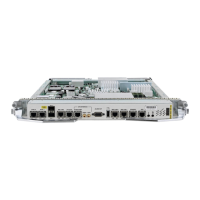4. interface [GigabitEthernet | TenGigE] instance.subinterface l2transport
5. encapsulation dot1q vlan-id
6. l2vpn
7. bridge group bridge-group-name
8. bridge-domain domain-name
9. interface [GigabitEthernet | TenGigE] instance.subinterface
10. interface [GigabitEthernet | TenGigE] instance.subinterface
11. Use the commit or end command.
12. show run interface [GigabitEthernet | TenGigE] instance.subinterface
DETAILED STEPS
Step 1 configure
Example:
RP/0/RSP0/CPU0:router# configure
Enters the Global Configuration mode.
Step 2 interface [GigabitEthernet | TenGigE] instance.subinterface l2transport
Example:
RP/0/RSP0/CPU0:router(config)# interface GigabitEthernet0/5/0/0.20
l2transport
Enters subinterface configuration mode and specifies the interface type, location, and subinterface number.
• Replace the instance argument with one of these instances:
• Physical Ethernet interface instance, or with an Ethernet bundle instance. Naming notation is
rack/slot/module/port, and a slash between values is required as part of the notation.
• Ethernet bundle instance. Range is from 1 through 65535.
• Replace the subinterface argument with the subinterface value. Range is from 0 through 4095.
• Naming notation is instance.subinterface, and a period between arguments is required as part of the notation.
Step 3 encapsulation dot1q vlan-id
Example:
RP/0/RSP0/CPU0:router(config-subif)#encapsulation dot1q 50
Assigns the matching VLAN ID and Ethertype to the interface.
Step 4 interface [GigabitEthernet | TenGigE] instance.subinterface l2transport
Example:
L2VPN and Ethernet Services Configuration Guide for Cisco ASR 9000 Series Routers, IOS XR Release 6.3.x
26
The Carrier Ethernet Model
Configuring an Attachment Circuit on an Ethernet Port

